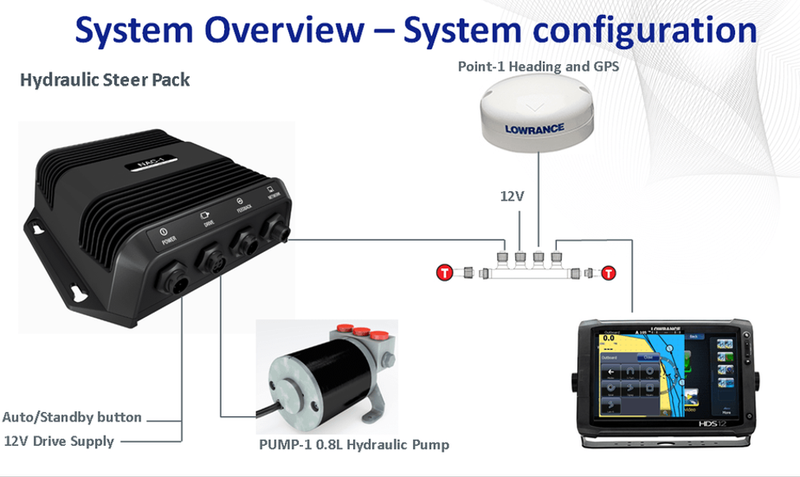Sale of Autopilots for Boats
Need a functional autopilot? The topRik marketplace has selected for you the best products produced in this segment of marine equipment. Just look at the brands to be convinced of the quality and reliability of the autopilots that you can choose and buy here: Lowrance, Furuno, Raymarine, Garmin, etc. Sale of autopilots through the topRik marketplace is a guarantee of high quality at a reasonable price. We deliver the selected autopilot to any location in the world.
What is an Autopilot on a Yacht for and How Does It Work?
An autopilot is a system consisting of electrical or electronic navigation devices capable of controlling the movement of a vessel without the need for constant human intervention. The autopilot allows the captain to step away from the helm of the boat for a certain period of time.
For a long time, such systems have been successfully used on commercial, sailing and other vessels, simplifying the navigation process and increasing its safety. Also, private sea and river small vessels, such as yachts and boats, can be equipped with autopilots.
A marine autopilot operates on similar principles to a car's cruise control system, except that it does not require manual control of the helm. Once the vessel maintains a given course for a certain time, the autopilot is activated, which then controls the movement of the vessel. The computer system remembers the path and automatically adjusts the rudder position to keep the boat on the chosen course even in strong wind or current conditions.
Types of Autopilots
This boat equipment is divided into various types depending on the location, drive type, ship control system and other parameters.
Depending on the location, autopilots are either above-deck or below-deck.
Above-deck Autopilots
This type of autopilot is an ideal solution for small vessels, boats and boats equipped with steering wheels or a steering wheel. This means equipment that is inexpensive, easy to use and maintain, and uses energy-efficient electrical connections. A wide selection of such autopilots in different price ranges makes them very affordable even for novice boat owners.
In turn, above-deck autopilots are divided into several subtypes.
Tiller autopilots – for vessels with a tiller control system. The most popular type of autopilot. They have been used for more than 30 years and are the cheapest and easiest to use. They are a remote control with a built-in magnetic compass and a drive mechanism.
Most tiller autopilots use an electric drive to control the helm. The computer transmits electrical signals to the drive, which changes the position of the tiller and allows you to stay on the selected course. Depending on the design, some devices are attached directly to the top of the helm.
Steering autopilots - suitable for almost all ships with a steering wheel control system. It has a control display and an induction compass, which can be installed independently at any convenient location. This type of autopilot communicates directly to the ship's helm using a belt or gears that are rotated by a low-power motor.
Below-Deck Autopilots
This subtype of autopilot is the best choice for motor and sailing vessels over 12 meters in length. They have more power, can perform a greater range of functions and provide better steering control for longer trips. At the same time, they consume more electricity and require more precise settings.
Below-deck autopilots typically consist of three elements.
- Course computer. The most important component, which includes a fluxgate compass, is responsible for stabilizing the course and orientation of the vessel on the water surface. It uses electronic means and synchronizes data with a gyroscopic compass. Fluxgate compass data can be linked to navigation charts, GPS and radar. The course computer also contains a magnetic and gyroscopic compass.
- Drive unit. This is the workhorse of the autopilot, which moves the steering wheel using electricity or hydraulics.
- Control block. This element serves as a kind of link between the steering device and the autopilot. It typically uses an LED screen to display information and various control elements such as knobs, joysticks or buttons.
Below-deck autopilots, in turn, differ in the type of drive, which can be:
- linear - most often used for sailing ships, runs on electricity and controls the movement of the rudder;
- rotary - used in chain and wheel systems equipped with sprockets of 13-25 teeth;
- hydraulic – installed on yachts and boats with hydraulic steering. The hydraulic drive assembly must match the size of the existing hydraulic plunger.
Wireless or below-deck autopilots are the most modern and functional autopilots with electronic filling.
Tiller and steering wheel autopilots have models with an on-board computer, the display of which reflects data on the route, direction and steering angle. For those cases where a steering position sensor cannot be installed, there is a separate series of on-board computers. Also, for each type of autopilot, wireless remote controls are offered, which can be used to remotely enable/disable the autopilot and control the route while being within a radius of up to 10 meters from the control element.
topRik marketplace presents models of the latest generation autopilots from the world's best manufacturers of marine equipment.
How to Choose an Autopilot for Your Yacht
topRik marketplace presents the most modern electronic control systems for a boat or yacht. At first glance, everything is simple and the same on all boats, only the panels and buttons are of different colors, but it only seems, underneath everything can be very different.
A comprehensive automatic ship control system usually consists of the following components: a compass, an electronic unit, a rudder drive, a rudder position indicator and an autopilot control panel. The connection of standard and additional system elements is carried out using a special data transfer protocol; each major manufacturer promotes its own protocol and wires.
A typical basic layout of an autopilot kit looks something like this:

The autopilot drive converts the electrical signal from the computer into mechanical force, which is transmitted to the steering wheel. Drives can be based on an electric motor or an electric hydraulic pump. Each system has its pros and cons, and the correct choice of drive type depends on several parameters: the type and size of the boat and displacement, as recommended by autopilot manufacturers.
But in fact, the question is deeper, firstly, the choice of drive power depends on the load and intensity of its work, and this in turn depends on the yacht itself, and not on its displacement. If the yacht is stable on course, well balanced with sails and has sufficient maneuverability, then the choice of drive according to the manufacturer’s recommendations will probably be more correct, but there are very few such boats nowadays, most of the mainstream ones suffer from poor handling (stability + maneuverability). A well-designed yacht in terms of handling is quite rare in the modern yacht market.
The second point that must be taken into account is the autopilot operating mode. Coastal sailing and autopilot operation for several hours a day are one thing, ocean sailing on a following wave 24 hours a day is another thing; these are fundamentally different loads on the drive.
An important parameter of any autopilot is power consumption; on average, a conventional autopilot consumes about 3-4 amps on a sail-balanced boat, this consumption can increase to 10 amps in stormy conditions.
Connecting and disabling the autopilot drive is usually done using an electromagnetic relay.
Electric Drive
This is the most common autopilot drive, easy to install and connect, provides sufficient force and does not require special maintenance.
A standard electric autopilot consists of a motor, gearbox and worm rod to transmit power to the tiller. The efficiency of a drive is generally determined by the efficiency of converting rotational motion into translational motion.
The main disadvantage of electric drives is that the gearboxes use plastic parts, which can simply break under certain conditions. Brush motors are also subject to wear and corrosion, which reduces their service life. The electromagnetic switch is also a subtle element in the system. The operating force of electric drives is also limited, therefore, on large yachts or work boats, electric drives are used less frequently than hydraulic drives. But in terms of price-reliability ratio, electric drives are the most common on small vessels.
Hydraulic Drive
This type of drive can provide greater force and is therefore used on large yachts and powerboats. The efficiency of the system is lower than the electromechanical one and is about 30% - this way, more electricity is consumed, which is critical on a small sailing yacht.
There are two types of this system, with a reversible pump and a constantly running pump.
The first option, when the pump rotates alternately in both directions, according to control signals from the autopilot, and the pressure is transmitted to the hydraulic cylinder of the drive.
In the second option, the pump rotates constantly and creates constant pressure in the system; the oil supply is switched by a system of valves, which are controlled by signals from the autopilot computer.
The second system consumes significantly more electricity, but is considered more reliable, since the motor operates in constant mode.
Therefore, when installing a hydraulic drive on a medium-sized yacht up to 50 feet, you need to think carefully about why this is justified and how it will be in operation.
The Electronic Unit
All operation of the autopilot is based on the “brains” in the autopilot computer unit; this is as important a component of the system as the drive.
Manufacturers are constantly improving the parameters: performance, sensitivity to pitching, accuracy of course holding, adaptability, etc., but often “new” models simply differ in the panel box and the size of the display and buttons, and the computer hardware is still the same as it was 5 years ago back.
Another element of the autopilot is the control panel or screen. What distinguishes an outwardly good autopilot from a bad one, given the essentially identical “brains”? A large and clear screen, large and clear buttons, and most importantly, a logical and simple control and configuration interface.
The most well-known manufacturers have a very conditional division by areas of application: Furuno - expensive, reliable, professional use; Raymarine - universal in use, moderate in price, most common, etc.
It should be taken into account that the displacement must be taken with a 20% margin so that the autopilot does not work in maximum mode - this will extend its service life. Accordingly, the cost directly depends on these parameters.
In addition, when purchasing, you need to decide whether you need an on-board computer and a remote control. The longer and longer trips you plan, the more likely you are to need them.
By choosing an autopilot, you choose an assistant, whose work will determine the quality of your sea voyages, and if we are talking about a sailing yacht, then the safety of the people on board. Therefore, the determining factor when choosing should not be cost, but functionality.
You will receive more detailed advice on each type and model of autopilots presented in this section for free from topRik marketplace experts. Contact them using the phone specified above, through Contacts section or send a message to [email protected].


